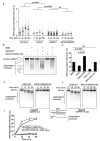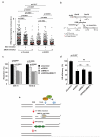EXD2 promotes homologous recombination by facilitating DNA end resection
- PMID: 26807646
- PMCID: PMC4829102
- DOI: 10.1038/ncb3303
EXD2 promotes homologous recombination by facilitating DNA end resection
Abstract
Repair of DNA double-strand breaks (DSBs) by homologous recombination (HR) is critical for survival and genome stability of individual cells and organisms, but also contributes to the genetic diversity of species. A vital step in HR is MRN-CtIP-dependent end resection, which generates the 3' single-stranded DNA overhangs required for the subsequent strand exchange reaction. Here, we identify EXD2 (also known as EXDL2) as an exonuclease essential for DSB resection and efficient HR. EXD2 is recruited to chromatin in a damage-dependent manner and confers resistance to DSB-inducing agents. EXD2 functionally interacts with the MRN complex to accelerate resection through its 3'-5' exonuclease activity, which efficiently processes double-stranded DNA substrates containing nicks. Finally, we establish that EXD2 stimulates both short- and long-range DSB resection, and thus, together with MRE11, is required for efficient HR. This establishes a key role for EXD2 in controlling the initial steps of chromosomal break repair.
Figures







References
-
- Malkova A, Haber JE. Mutations arising during repair of chromosome breaks. Annual review of genetics. 2012;46:455–473. - PubMed
-
- Krogh BO, Symington LS. Recombination proteins in yeast. Annual review of genetics. 2004;38:233–271. - PubMed
-
- Symington LS, Gautier J. Double-strand break end resection and repair pathway choice. Annual review of genetics. 2011;45:247–271. - PubMed
Publication types
MeSH terms
Substances
Grants and funding
LinkOut - more resources
Full Text Sources
Other Literature Sources
Molecular Biology Databases

